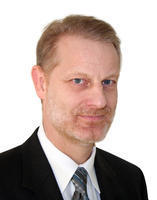Interview with Søren Holst, President, GN Otometrics
Dybala: I have the pleasure today of speaking with Søren Holst, the President of GN Otometrics. His company has recently released three new products in the market, the ICS Chartr 200 VNG/ENG system, the Madsen Xeta audiometer and the Aurical Visible Speech System . All three relate to GN Otometrics' focus on Intelligent Integration. Søren, thank you for being here to today.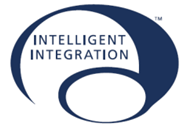 Holst: Good to talk with you!
Holst: Good to talk with you!
Dybala: Tell us about GN Otometrics and Intelligent Integration.
Holst: Intelligent Integration is a concept for everything that we do at GN Otometrics, from audiometers to VNG systems. We don't want to build standalone measuring devices. There is a workflow and a process when working in a clinic or private practice and we want to facilitate that. Think about some of the equipment and systems that are typically found in a clinic:
- 2-channel Audiometer
- Real Ear Measurement
- Visible Speech
- Hearing Loss Simulator
- Master Hearing Aid
- Video Otoscopy
- Immittance
- Hearing Instrument Test System
- NOAH3
- Fitting Software
Imagine, instead of each of these items being standalone equipment or software, they are all a part of one overall system. Now that everything is integrated, you can enter your patient data into any part of the system once, and can access it easily from any other part of the system.
Dybala: Basically, the end of having to enter data two and three and four times on different pieces of equipment in order to work with a patient.
Holst: Correct. All of our systems take advantage of the power of the personal computer and so we are able to offer these types of solutions. These systems are not only powerful, but very easy to use. This is why at GN Otometrics we talk about Intelligent Integration. Integration is only half of the equation. Everything that we have developed has been based on user input so our systems have advanced features, but they are also intuitive and easy to use. This not only enhances the patient experience, but creates a nice workflow for you, saving you time.
Dybala: Let's talk about how GN Otometrics is using Intelligent Integration to improve the hearing aid selection and fitting process.
Holst: Hearing aids are becoming more and more advanced and audiologists need to have more sophisticated tools to evaluate these devices. Additionally, the hearing aid patients of today are more informed and want to be more involved in the fitting process. Patients want to have a better understanding of what their hearing aids are doing. GN Otometrics has come out with the ultimate solution for the aforementioned needs; we call it AURICAL Visible Speech.
Dybala: How is the AURICAL Visible Speech system different from other systems in the market?
Holst: The Aurical Visible Speech System is the next generation of Visible Speech and easily a step above anything else on the market. This starts with a newly developed wireless neck unit that houses the probe tube unit and communicates wirelessly with your computer. We call the neck unit SpeechLink.
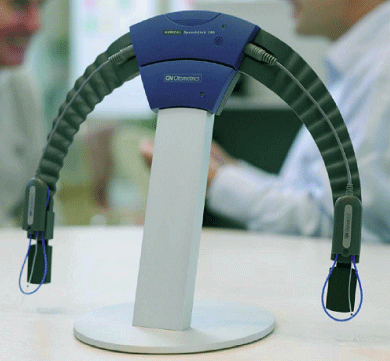
The wireless SpeechLink unit of the AURICAL Visible Speech System
Dybala: If you want to sell high-tech hearing aids, you want to have a high-tech image.
Holst: Correct. When patients go into a clinic or office and see it for the first time they are normally intrigued by the design and ask about it. It is a great way to talk about the advanced fitting and verification techniques that your office uses.
Dybala: Well, I am looking at it and I am intrigued. It's very different from other real ear units I have seen.
Holst: The neck unit is counterbalanced with weights so it simply rests on the patient's shoulders. There are no clips or anything attached to the patients clothing. This makes it easy on and easy off. The unit will also work to connect physically with NOAHLink so that you can wirelessly program your hearing aids and perform probe tube measurements. This neck unit uses a binaural probe tube measurement system so you can perform simultaneous binaural measurement and do not have to switch probe from one ear to the other.
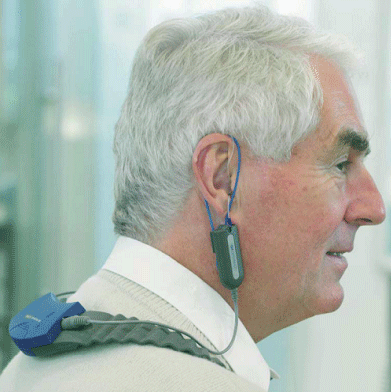
Example of a patient wearing the wireless SpeechLink unit.
Dybala: A helpful time saver and this is very clever the way your probe measurement neck unit attaches to NOAHLink. Normally, with other systems, patients would have two separate pieces of equipment hanging on them (probe measurement system & NOAHLink). The way that SpeechLink physically connects to NOAHLink makes it feel like you are only wearing one item.
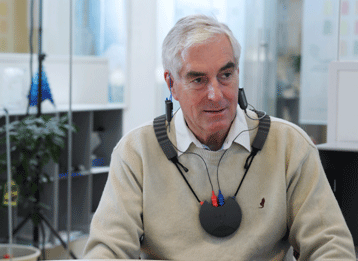
SpeechLink connected to NOAHLink.
Holst: The patient is connected wirelessly and can walk around your clinic or even out of your clinic and you can measure what the aid is doing. You could send them into your test booth for a speech in noise test or into a simulated living room at your office to listen to the hearing aids.
Dybala: I just tried on the neck unit and NOAHLink and it was very comfortable, not very heavy at all. Due to the counterbalancing, you don't feel like you have a lot on your shoulders.
Holst: At some of our beta sites we have patients who forgot they were wearing it and they almost walked out of the clinic with it!
Dybala: I know that NOAHLink used Bluetooth for wireless connectivity. Is this what your device uses as well?
Holst: Yes, Bluetooth was designed for these types of applications and it works very well with little or no interference from other wireless sources.
Dybala: Let's get into the Visible Speech software itself.
Holst: The Visible Speech software is fully integrated with NOAH so that all the audiometric data is pulled in from the database and is shown on the screen. You can also put in the information directly into the visible speech system as a standalone.
I have to do a little bragging here. This is a really nice piece of software. It is really clean in design and really easy to use. There are three main modules that can be used during the counseling and fitting process: Hearing Loss Simulator, Hearing Instrument Simulator and Speech Mapping. This software is so well designed that currently it is widely used in Germany as a standard counseling and fitting tool. In a sense, it is a step by step tutorial that guides the patient from explaining their hearing loss, to demonstrating how amplification could help with their loss and finally verifying the fit of their hearing aid.
Dybala: I think it would be good to go through how the three parts of the system are used.
Holst: To start off with, the Hearing Loss Simulator is good for the patient who comes in with a spouse or significant other. It gives the significant other an idea of what the person with hearing loss is experiencing and how they hear. It also helps the patient to get a visual explanation of their hearing loss. Many audiologists actually start with the Hearing Loss Simulator before they start talking about hearing aids at the initial appointment. They use it to explain normal hearing and then the hearing loss and where speech information resides.
Dybala: It helps to give the patient a reference point, correct?
Holst: The better your patient understands their hearing loss, the easier it will be to explain what hearing aids do and how they work. This is why we use the SPLgram format to display hearing loss threshold and for the real ear measures, everything is displayed on the same graph.
Dybala: Walk me through what you would do to take a person through the Hearing Loss Simulator. What's a typical example of how it is used?
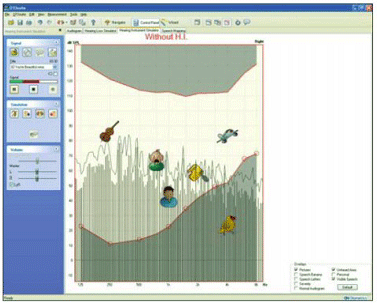
A screen shot from the Hearing Loss Simulator showing thresholds,
uncomfortable levels, familiar sounds and live speech in the SPLgram format.
Holst: As I mentioned above, the first step would be to bring up the patients hearing loss using SPLgram display for counseling purposes. As a part of the counseling process I like to play music samples from our software to give an example of what the patient can and cannot hear. We have an entire library of recorded sounds that comes with the system, so you may even want to pick out a sound based on information provided in the patient's case history. After the prerecorded sound samples I would then change to live voice input. Recording the voice of the significant other, and then playing it back in the Hearing Loss Simulator is really a powerful demonstration of the interaction between the patient's thresholds and speech.
Using the Hearing Loss Simulator the significant other could then listen to various speech sounds with and without a simulated hearing loss based on the patient's audiogram. The software makes it easy to toggle between these modes for quick comparison. This process helps not just the patient, but the significant other understand the impact of the loss. What is key throughout this entire process is that everyone involved is able to see and hear what is happening.
Dybala: I like to say that we are all "visual animals" and so multi-modality is always best! The way that this is all presented in the SPLgram is really powerful. What is the next step?
Holst: Typically, once the Hearing Loss Simulator module is completed you can move into the Hearing Instrument Simulator. At this point the patient puts on a pair of headphones and they can listen to the significant other talking or signals from our sound library and have it amplified based on the patient's hearing loss. Both persons get to see what is happening on the screen and your patient can also hear what is changing. This is why using this as an initial counseling tool is so powerful; it ties out to your initial explanation of the audiogram and what can and cannot be heard.
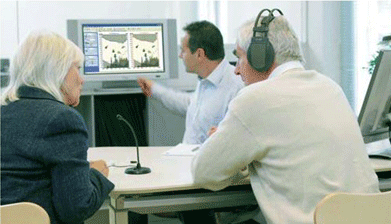
Use of the Hearing Loss Simulator Module with the AURICAL Visible Speech system.
Dybala: What is the type of amplification that you are providing in the simulator?
Holst: It is a nonlinear response based on the NAL NL fitting method.
Dybala: NAL NL1 and DSLi/o are becoming more and more common as the default fitting methods on many digital hearing aids, so this sounds like a good place to start. Up until this point we have been able to counsel the patient about their hearing loss, we have been able to simulate the hearing loss for the significant other and provide a demonstration of what amplification could sound like to the patient. This same system can now be used to verify the fitting.
Holst: Remember, not only can you use this system to verify new fittings; it could be used to compare an old hearing aid to a new hearing aid as well. If your patient has a hearing aid that is 5-10 years old and they are not sure about moving to newer technology, the real ear system can help the person see the advantages of the newer digital instruments.
As I mentioned earlier, the power of this system when used for demonstration, comparison or verification is that measurements are all made on the same SPLgram. It brings everything back to the initial counseling session and is a great frame of reference to start from. The same screen used to explain the hearing loss can now be used to demonstrate advanced features like noise reduction and directionality.
Dybala: At this point you are programming the hearing aids through various pieces of software, while performing real ear measurements through the Visual Speech Mapping Software. How does this work with two sets of software running and being able to see what is going on with both of them?
Holst: We have what we call "On-top mode". We reduce the size of the real ear screen and let it float above the hearing aid fitting software. This way you can easily access both so that you can adjust the hearing aid and see the response.
Dybala: I would also mention that many newer laptops come with dual video cards so you could also have two screens running as well, one with the fitting software and the other with the Visual Speech Mapping screen. Making the speech map the "Star" of the fitting for the patient and letting you focus on the fitting software.
Holst: Yes, dual monitors work very well and with the price of LCD monitors getting more and more reasonable, you can usually get a good price on one.
Dybala: I assume that you can use pretty much any signal you want with your real ear system?
Holst: You can use live speech, speech weighted noise, really any sort of signal that you like. Our system comes with everything from a built ICRA noise, and speech babble, plus a collection of environmental sounds. Airplane noise, traffic noise, babies crying, almost anything you can think of. Overall, we have found that the most powerful signal is the use of the live speech. They can see what is happening or what is not happening with the hearing aid. You can also record the person's voice and use it multiple times if you want to do comparisons with a consistent sample.
Just imagine that you spend 5 minutes up front in the initial fitting, using Speech Mapping to verify that the first fit is right. This will in many cases save you from sending the patient home with wrong loudness or balance in the fitting.
Dybala: Well Søren, thank you for spending some time with me and talking about your new systems and the GN Otometrics approach with Intelligent Integration. I will give you the last word of the interview.
Holst: Paul, it has really been my pleasure and I am happy to talk with you and the Audiology Online readers. Intelligent Integration is all about making it easier for the clinician to work with the patient and in the end this really helps to improve patient care. As you mentioned at the start of this interview, GN Otometrics has also released a new audiometer, the Madsen Xeta and a new VNG/ENG system the ICS Chartr 200. Both the hardware and software aspects of these two systems have also been designed with the goal of advanced integration and features with intelligent and easy to use software. If any of the Audiology Online readers are interested in ways to improve any aspects of the evaluation and rehabilitation of patients, I would encourage them give GN Otometrics a call!
About GN Otometrics:
Copenhagen-based GN Otometrics is the world's leading manufacturer of hearing and balance instruments and software. The company has solutions that range from infant-screening applications and audiologic diagnostics to balance testing and hearing-aid fitting. More information about GN Otometrics can be found at www.gnotometrics.com


